Blog
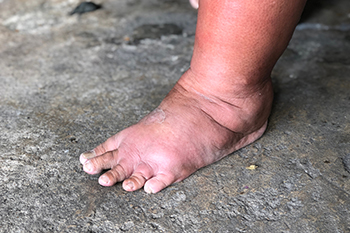
Swollen feet may result in foot pain, and can happen from various factors, each impacting overall health. High salt intake often leads to fluid retention, causing swelling in the feet. Being overweight puts extra pressure on the feet, leading to discomfort and swelling. Certain medications, such as those for high blood pressure or diabetes, can also cause fluid retention and swelling as a side effect. Additionally, Insect bites may trigger localized swelling due to an allergic reaction or inflammation. More serious underlying conditions, such as heart or kidney problems, can lead to poor circulation and fluid buildup in the lower extremities. Identifying the root cause of swollen feet is essential for effective treatment, which may include lifestyle changes, medication adjustments, or medical intervention. If your feet have become swollen, it is suggested that you visit a chiropodist who can offer you effective relief and treatment options.
Foot pain can have many causes. To receive an accurate diagnosis and treatment for your foot pain, please consult with one of the chiropodists from The Footcare Centre. Our chiropodists will assess your condition and provide you with quality foot and ankle treatment.
Causes
There are a variety of different conditions that can cause foot pain, including:
Plantar fasciitis
Deformities, such as bunions or hammertoes
Injuries to the muscles, bones, tendons, or ligaments in the feet
Arthritis
Flat feet
Ingrown toenails
Symptoms
The type and location of your foot pain can help determine what may be causing it and what type of treatment options are best for you.
Common types of foot pain include:
Heel pain
Arch pain
Toe pain
Ball of foot pain
Pain that has a stabbing, burning, or tingling quality
Pain that is constant, intermittent, or that gets better or worse depending on the situation
Diagnosis
A thorough medical history and physical examination of your feet will be required to determine a diagnosis. Imaging studies, such as X-rays or MRIs may be performed to rule out or confirm certain diagnoses.
Treatment
Treatment will depend on the cause of the pain. Common treatments for foot pain include resting, icing, compressing, and elevating the affected foot, wearing orthotics, or taking anti-inflammatory medications.
If you have any questions, please feel free to contact our office located in . We offer the newest diagnostic and treatment technologies for all your foot care needs.
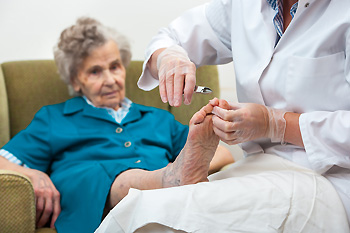
As we age, our feet undergo various changes that can lead to common foot problems among elderly individuals. One prevalent issue is bunions, where the big toe joint becomes swollen and painful due to the misalignment of the bones. Another common concern is hammertoes, characterized by the abnormal bending of the toes, often causing discomfort and difficulty in wearing shoes. Additionally, elderly individuals frequently experience foot pain from conditions such as arthritis, which can cause inflammation and stiffness in the joints. Furthermore, decreased circulation and nerve damage can lead to peripheral neuropathy, resulting in numbness, tingling, and a heightened risk of foot injuries. To alleviate these issues, it is essential for seniors to wear comfortable and supportive footwear, maintain proper foot hygiene, and seek regular care from a chiropodist to address any emerging problems promptly. If you are elderly and are experiencing any type of foot pain, it is suggested that you are under the care of this type of doctor who can help you find relief.
Foot problems can become increasingly common as we age, making everyday foot care especially important. To learn more about maintaining proper foot health, please consult with one of the chiropodists from The Footcare Centre. Our chiropodists will assess your condition and provide you with quality foot and ankle treatment.
Common Foot Problems
Certain foot problems may be more likely to affect older adults.
Some examples of foot conditions that can be common in older adults include:
Dry, cracked skin
Calluses and corns
Blisters
Ingrown toenails
Deformities such as bunions or hammertoes
Fungal infections
Plantar warts
Systemic conditions, such as diabetes or arthritis, are also more likely to affect older people and manifest symptoms in the feet and ankles.
Daily Foot Care Tips
Having a daily foot care routine can help detect problems early on and prevent future issues.
Things that you can do at home to care for your feet include:
Washing the feet daily with warm water, drying them thoroughly, and then applying a moisturizer
Trimming the toenails straight across and not too short to prevent ingrown toenails
Performing daily foot exercises to improve foot strength and mobility
Wearing shoes when walking to avoid injury
Inspecting the feet daily for any cuts, scrapes, sores, or other abnormalities and seeking prompt treatment if any problems are discovered
If you have any questions, please feel free to contact our office located in . We offer the newest diagnostic and treatment technologies for all your foot care needs.
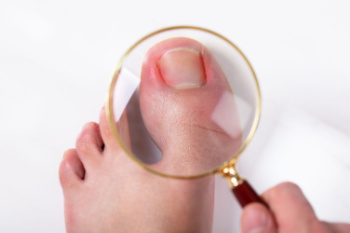
Ingrown toenails occur when the edge of a toenail grows into the surrounding skin, causing pain and inflammation. In stage one, the toe is swollen and tender with mild pain. Stage two involves increased pain, redness, and possible infection with pus. In stage three, the inflammation is severe, and there is significant infection and overgrowth of skin tissue. Symptoms progress from discomfort and redness to intense pain and oozing fluid. Preventing ingrown toenails involves proper nail care, consisting of trimming toenails straight across without rounding the corners, avoiding cutting them too short, and wearing shoes that fit well to reduce pressure on the toes. Maintaining good foot hygiene and regularly inspecting the feet can also help prevent the development of ingrown toenails and the complications associated with them. If you have developed an ingrown toenail, there may be significant pain, and it is suggested that you consult a chiropodist who can effectively treat this condition.
Ingrown toenails may require medical attention. If you have significant pain or notice signs of infection from an ingrown toenail, please consult with one of the chiropodists from The Footcare Centre. Our chiropodists will assess your condition and provide you with quality foot and ankle treatment.
What Is an Ingrown Toenail?
An ingrown toenail occurs when the edges of a toenail grow into the surrounding skin. The toenails of the big toe are usually affected, however, an ingrown toenail can happen on any toe. Sometimes, the area can become infected leading to potentially serious complications. The ingrown toenail may be caused by improper trimming of the toenail, wearing ill-fitting shoes, or injury to the nail.
Symptoms
The symptoms of an ingrown toenail include:
Pain
Swelling
Redness
Warmth
Pus or drainage from the affected nail or a fever may indicate an infection of the area.
Treatment
Treatment depends on the severity of the ingrown toenail. In less severe cases, home treatment may be adequate. Soaking the affected foot in warm water and gently lifting the nail from the skin with a piece of clean cotton can help. In more severe cases, you may need to use topical or oral antibiotics to treat an infection. Surgical removal of the ingrown toenail may be required if more conservative treatments fail.
Ingrown toenails may be prevented by wearing well-fitted shoes and properly trimming the toenails. Toenails should be trimmed straight across and not too short when using nail clippers.
If you have any questions, please feel free to contact our office located in . We offer the newest diagnostic and treatment technologies for all your foot care needs.
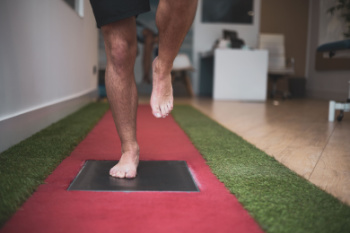
The proper running foot strike is a critical element in enhancing performance and preventing injury. It refers to the part of the foot that first makes contact with the ground during a stride. There are three main types of foot strikes, which are heel, midfoot, and forefoot. Experts often recommend a midfoot or forefoot strike for most runners as these methods can promote a more natural running form, reduce the impact on joints, and improve overall efficiency. To achieve this, runners should focus on landing softly with their foot directly beneath their hips, rather than in front of the body. This technique helps in maintaining proper alignment and balance. A slight forward lean from the ankles, not the waist, can also aid in promoting a more efficient foot strike. Additionally, increasing cadence, or the number of steps taken per minute, can help in adopting a lighter and more responsive foot strike. If you have endured a foot injury due incorrect running form, it is suggested that you visit a chiropodist who can offer you relief methods, in addition to guiding you toward the correct running form.
The biomechanics of your feet play an important role in your foot health. To learn more, please consult with one of the chiropodists from The Footcare Centre. Our chiropodists can help you maintain the health of your lower limbs and your mobility.
Foot biomechanics refers to the study of the structure, function, and motion of the feet. The feet and ankles are a complex system consisting of many bones, joints, ligaments, muscles, and tendons that work together to move your feet. Understanding the unique biomechanics of your own feet can help you and your chiropodist make informed decisions about your foot health care. This includes decisions about the best preventive measures to avoid foot pain, the best treatment options for various foot problems, and finding the best shoes for your feet.
If you have any questions, please feel free to contact our office located in . We offer the newest diagnostic and treatment technologies for all your foot care needs.

Corns are painful, thickened areas of skin that commonly form on the small toes due to increased pressure from bony prominences. This pressure causes the skin to harden and thicken, resulting in discomfort, especially while walking. Non-operative treatment options for corns include padded corn sleeves, which distribute pressure more evenly, and toe spacers, which reduce friction between the toes. Corn donuts are another useful tool, off-loading pressure from the central painful area to the surrounding skin. Regularly trimming the callus can also help, though it is best to be done by a chiropodist, as the corn often recurs if the underlying issue is not addressed. In some cases, an X-ray may be necessary to identify the bony prominence causing the corn. Surgery is rarely needed, but can be considered if conservative treatments fail. Surgical options focus on removing the bony prominence and possibly straightening the affected toe joint. If you have painful corns, it is suggested that you schedule an appointment with a chiropodist who can determine what the best course of treatment is for you.
Corns are small bumps or dry, hardened skin that can arise on the feet, usually in response to friction. Corns can be asymptomatic, or they can be uncomfortable or painful. If you have corns that are bothering you, please consult with one of the chiropodists from The Footcare Centre. Our chiropodists can help you maintain the health of your lower limbs and your mobility.
There are three types of corns:
Hard corns
Often occur on the tops of toes
Feature a hard core surrounded by dry, irritated skin
Can be painful
Soft corns
Often occur in between the toes
Soft due to constant exposure to sweat
Can be painful
Seed corns
Tiny
Often occur on the soles of the feet
Usually asymptomatic
Corns can be prevented by wearing shoes that fit properly. They are typically benign and don’t require medical treatment. However, if your corns are causing you pain or discomfort, don’t hesitate to reach out to a chiropodist near you for treatment options. If you have any questions, please feel free to contact our office located in . We offer the newest diagnostic and treatment technologies for all your foot care needs.
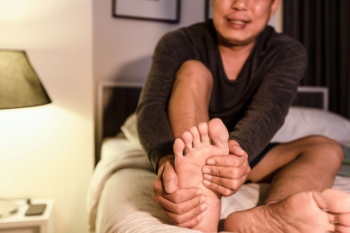
Nerve damage in the feet, especially in the ball of the foot, is a painful issue that can disrupt daily life. This main cause is irritation of nerves between the toes, leading to their enlargement and the formation of benign neuromas. Morton’s neuroma, which typically occurs between the third and fourth toes, is an example, more commonly affecting women. Early symptoms of this type of nerve damage include a mild ache or tingling surrounding the toes, which can progress to a persistent burning sensation that radiates to the tips of the toes. These symptoms are often worsened by wearing tight or non-supportive shoes, combined with thinning fat pads in the foot and poor foot posture. Diagnosis usually involves a thorough examination and history review by a chiropodist, with imaging tests sometimes used to exclude other conditions. Treatment generally focuses on changing footwear, using orthotic devices, and possible injections of corticosteroids to relieve pain. In some cases, cryotherapy or alcohol injections might be effective. If you are experiencing symptoms of nerve damage in the feet, it is suggested that you schedule an appointment with a chiropodist for an exam and diagnosis, followed by a personalized treatment plan.
Neuropathy can cause permanent nerve damage if left untreated. If you are experiencing the symptoms of peripheral neuropathy, please consult with one of the chiropodists from The Footcare Centre. Our chiropodists will assess your condition and provide you with quality foot and ankle treatment.
What Is Peripheral Neuropathy?
Peripheral neuropathy is a condition that damages the nerves of the peripheral nervous system, which provide sensation to the limbs. The feet are often affected. Peripheral neuropathy can have many different causes, but it is most commonly associated with diabetes.
Symptoms
Common symptoms of peripheral neuropathy include:
Pain
Numbness or tingling sensation
Burning sensations
Weakness
Loss of balance
Diagnosis
Peripheral neuropathy is diagnosed based on medical history and physical examination. Various tests performed during physical examinations can help determine the type of peripheral neuropathy you may have and what is causing it.
Treatment
Treatment for peripheral neuropathy will depend on what is causing it. For example, if your peripheral neuropathy is caused by diabetes, then managing your blood sugar, exercising regularly to strengthen the legs and feet, and taking pain medications may be recommended as treatments.
If you have any questions, please feel free to contact our office located in . We offer the newest diagnostic and treatment technologies for all your foot care needs.
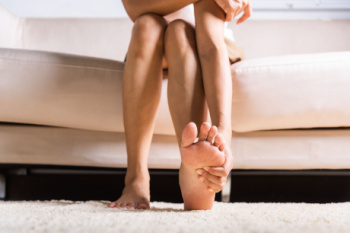
Foot pain can affect anyone, anywhere on the foot, from the heel to the toes, and even the arch and sole. Factors that contribute to foot pain include age, prolonged standing, excess weight, and congenital foot deformities. Injuries, wearing ill-fitting shoes, and intense physical activity are other culprits. In addition to injuries, conditions such as arthritis, gout, flat feet, and plantar fasciitis are among the more common causes of foot pain. One way to help manage foot pain involves wearing properly fitting shoes with sufficient support and cushioning. This also may include custom orthotic shoe inserts to correct any biomechanical issues that are contributing to the particular condition. Warming up before exercise, regular stretching, maintaining a healthy weight, and strengthening foot muscles through exercises are methods to avoid foot pain. However, persistent or worsening foot pain warrants professional attention from a chiropodist. This foot specialist can conduct a thorough exam and devise an appropriate treatment plan. It is suggested that you make an appointment with a chiropodist to address foot pain concerns.
Foot pain is a common problem treated by chiropodists. If you have foot pain, please consult with one of the chiropodists from The Footcare Centre. Our chiropodists can help you maintain the health of your lower limbs and your mobility.
When you are experiencing foot pain, it’s important to note the type of pain and its location, as this can help determine a diagnosis.
Pain in the top of the foot may be caused by:
Stress fractures
Sinus tarsi syndrome
Extensor tendonitis
Tibialis anterior tendonitis
Gout
Athlete’s foot
Ganglion cysts
Pain in the bottom of the foot may be caused by:
Plantar fasciitis
Foot cramps
Tarsal tunnel syndrome
Plantar fibromatosis
Posterior tibial tendonitis
Stress fractures
Flat feet
Pain on the side of the foot may be caused by:
Ankle sprain
Cuboid syndrome
Peroneal tendonitis
Stress fractures
Bunions
Corns or calluses
Posterior tibial tendonitis
Heel pain may be caused by:
Plantar fasciitis
Achilles tendonitis
Bone spurs
Heel fractures
Retrocalcaneal bursitis
Sever’s disease
Pain in the toes may be caused by:
Gout
Hammertoe
Turf toe
Bunions
Ingrown toenails
Blisters
Arthritis
These and many more conditions can be treated by a chiropodist. If you have any questions, please feel free to contact our office located in . We offer the newest diagnostic and treatment technologies for all your foot care needs.
Blog Archives
- 2024
- 2023
- 2022
- 2021
- 2020



